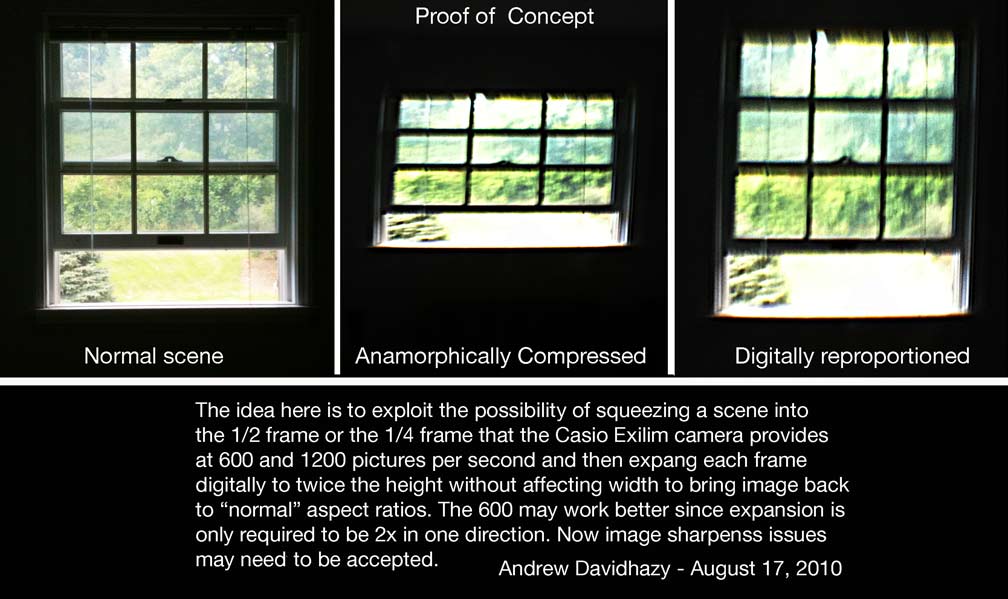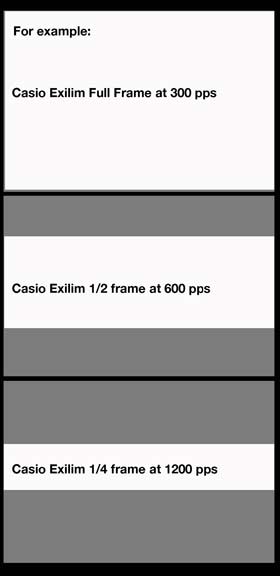|
The CASIO Exilim camera used in high speed
recording mode
Andrew Davidhazy
School of Photo Arts and
Sciences/RIT
Rochester, NY
By way of introduction I'd like to state that this how a fleeting idea
possibly becomes the basis for further "research" and
a possible solution to a vexing "problem" in high speed photography
especially as illustrated by the Casio Exilim camera. It is presented
here
acknowledging that no research has been done into whether this was
something already suggested by someone else in the world.

The Casio Exilim camera is capable of 300 full frame pictures per
second.
Quite a feat in itself and useful for many applications. But the camera
is also touted as being able to record 600 and even 1200 pictures per
second.
 How does the camera
accomplish this feat? Well, like all high speed cameras do in a manner
of speaking. The camera gives up "spatial" resolution in order to gain
"temporal" resolution. And so what does this mean? How does the camera
accomplish this feat? Well, like all high speed cameras do in a manner
of speaking. The camera gives up "spatial" resolution in order to gain
"temporal" resolution. And so what does this mean?
It means that if one needs to transfer fewer data points than are
required for a full frame of information one can, instead of
transferring all the data associated with one frame, concentrate on a
new set of data points (a new "frame") and devote 1/2 the time to one
image and the other half of the time to the next one. Effectively this
doubles the framing "rate".
So what does the camera do to go to 600 pictures per second? It simply
cuts the frame into 1/2 and this is called now a 1/2 frame aspect ratio
camera. The frames are 1/2 as tall as the full frame and they are dealt
with in 1/2 the time as a full frame might be. And how about 1200
pictures per second? Well, the frame is cut in half again and the time
available for each quarter frame is 1/4 of the time required for the
full frame. So 300 x 4 - 1200 pictures per second.
This is how most high speed film cameras achieve similar results. Give
up frame size to gain framing rate. In these cases one ends up with
rather unusual aspect ratios for the recorded frames. Maybe suitable
for
photographing arrows or similar objects i flight but usually not too
practical for more likely scenes that call for an aspect ratio of maybe
3x4 as in traditional TV format.
What to do? Here is a suggestion:
Place an anamorphic lens in front of the Casio camera's lens at the
time it is being used in the high speed, 600 pps mode and make a
recording.
What is an anamorphic lens? It is one that shrinks the field of view of
a an imaging system in one direction but not the other. In is simplest
form it is negative cylindrical lens. Most image forming lenses are
convex or positive. Anamorphic lenses are cylindrical and negative
(usually) in focal length (if I recall correctly).
The anamorphic lens, placed in front of the prime lens and oriented in
such a manner that it
compresses a scene in the vertical dimension while not affecting the
horizontal one, shrinks the vertical field of view to fit, let's say,
within the confines of the reduced vertical dimension of the
sensor (at 600 pps it is 1/2 as tall as it is full frame as
stated earlier).
After the record is made each image of the stack of images making up
the sequence are resized while unconstraining the dimensions of the
image. So an image that in its full frame size could be maybe 2000 x
3000 pixels, when used at 600 pps is reduced in size to 1000 x 3000
pixels. Then each image is uncostrained in proportions and the vertical
dimension is "amplified" by digital interpolation to twice its vertical
dimension. This then makes each frame taken at 600 pps the same size as
one that would be made at full resolution and possibly suitable for
easier visual examination than one which has an odd aspect ratio,
Further, if the anamorphic component shrinks the files size to 1/4 its
normal coverage one can envision :full frame" aspect ratio images that
have the "look" of a full frame high speed movie made at 1200 pictures
per second!
IMPORTANT NOTE: You
seldom get something for nothing and that is the
case here as well. Obviously the system is "interpolating" image data
rather than actually capturing "real" data. Can one trust the
interpolation? In my opinion it is often quite acceptable to do this.
What other price is there to pay?
Well, the images will suffer from a
certain degree of optical deterioration associated with photographing
through an anamorphic lens element. Will the results be acceptable?
This
is for each individual to determine for themselves. In some cases no
but
in some cases yes.
In closing I should mention that some cameras accomplish similar
modification for full-frame recording rates but not by cutting a frame
simply in height but the software allows the user to simply select
smaller areas within the full sensor to be sampled or used as the basis
for each image of the stack. This simply results in a loss of spatial
resolution while keeping the aspect ratio of the individual frames at
some desired relationship. One might call this "2nd generation" image
splitting!
There are many ways to solve a problem. Often this involves
compromises.
This is very evident though out the field of high speed photography.
Now to see if someone already suggested this. Somebody probably already
has I bet. But for me this was something to think about this evening.
|